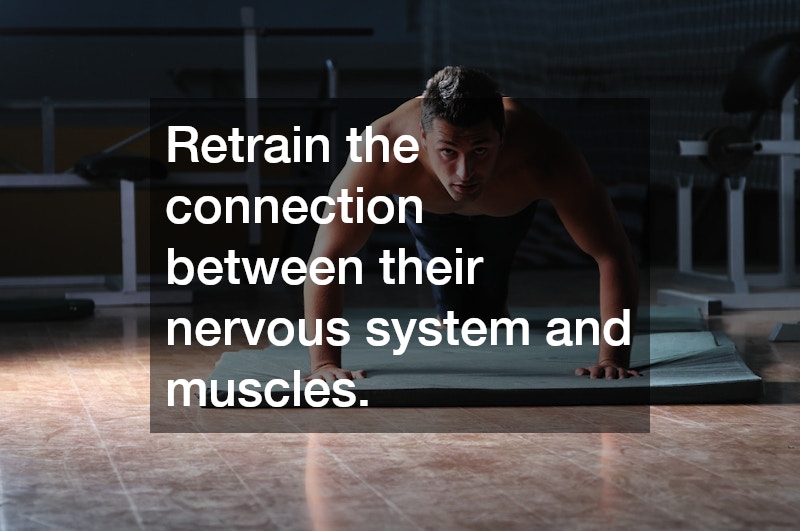
Disclaimer: This website provides health information for educational purposes only and is not a substitute for professional medical advice, diagnosis, or treatment. Always seek the guidance of a qualified healthcare provider with any questions you may have.
Neuromuscular reeducation treatment is an innovative and effective approach used to help patients regain control over their muscles and improve movement patterns after an injury, surgery, or neurological condition. This therapeutic technique is often used in physical therapy to address a wide range of conditions, including muscle weakness, balance issues, coordination problems, and mobility limitations. By focusing on retraining the nervous system and muscles to work together more efficiently, neuromuscular reeducation can significantly enhance a patient’s ability to perform daily tasks and participate in physical activities.
In this blog, we’ll explore what neuromuscular reeducation treatment is, how it works, and the types of conditions it can help address.
1. What Is Neuromuscular Reeducation?
Neuromuscular reeducation is a therapeutic technique that helps patients retrain the connection between their nervous system and muscles. It’s designed to improve the way muscles and nerves communicate, which is essential for smooth, coordinated movement. When this communication is disrupted due to injury, surgery, or neurological disorders, patients may experience difficulty with balance, coordination, or even basic motor functions.
Neuromuscular reeducation treatment involves exercises and techniques aimed at restoring proper movement patterns, muscle control, and joint stability. These exercises help to “re-educate” the muscles and nerves to work together efficiently, reducing compensatory movement patterns and minimizing the risk of further injury.
2. How Does Neuromuscular Reeducation Work?
The body’s ability to move efficiently relies on a complex interaction between the brain, spinal cord, nerves, and muscles. When this system is disrupted due to injury or a neurological condition, the muscles may not receive the correct signals from the nervous system, leading to impaired movement and coordination. This is where neuromuscular reeducation comes into play.
Through specific exercises, stretching, and manual therapy techniques, neuromuscular reeducation treatment helps to retrain the muscles to respond appropriately to nerve signals. The goal is to restore normal movement patterns, enhance muscle control, and improve proprioception (the body’s sense of its position in space). These improvements can help reduce pain, enhance mobility, and prevent future injuries.
Neuromuscular reeducation focuses on:
Improving joint stability: By enhancing muscle coordination and control, patients can reduce stress on their joints and improve overall stability.
Restoring balance and posture: Balance and postural exercises are key components of neuromuscular reeducation, as they help patients maintain proper alignment and movement.
Enhancing movement efficiency: Patients learn to perform movements more smoothly and efficiently, reducing compensatory patterns that can lead to further injury.
3. Conditions Treated by Neuromuscular Reeducation
Neuromuscular reeducation treatment can be beneficial for a wide range of conditions, particularly those that involve impaired movement, muscle weakness, or coordination issues. Some of the most common conditions treated with this therapy include:
Sports injuries: Athletes who have suffered injuries such as sprains, strains, or ligament tears often benefit from neuromuscular reeducation to restore proper muscle function and prevent future injuries.
Post-surgical recovery: After surgeries like knee or hip replacements, patients may need to relearn how to walk and move efficiently. Neuromuscular reeducation helps patients regain strength and coordination during rehabilitation.
Neurological conditions: Patients with conditions such as stroke, Parkinson’s disease, or multiple sclerosis often experience difficulties with movement and coordination. Neuromuscular reeducation can help these patients improve their balance, mobility, and muscle control.
Chronic pain: Individuals with chronic pain conditions, such as fibromyalgia or back pain, may benefit from neuromuscular reeducation to improve posture, alignment, and movement patterns that reduce pain and discomfort.
Balance disorders: Older adults or individuals with balance issues may use neuromuscular reeducation to improve their stability and reduce the risk of falls.
4. What to Expect During Neuromuscular Reeducation Treatment
A typical neuromuscular reeducation treatment session is highly personalized to address the specific needs of the patient. The therapist will conduct a thorough evaluation to assess the patient’s movement patterns, posture, balance, and muscle function. Based on this assessment, a customized treatment plan is created to target areas of weakness or dysfunction.
Treatment may include:
Proprioceptive exercises: These exercises help patients improve their sense of body position and movement, which is critical for coordination and balance. This may include exercises on unstable surfaces, such as balance boards or foam pads, to challenge the body’s ability to maintain stability.
Manual therapy: Hands-on techniques, such as joint mobilizations and soft tissue massage, may be used to enhance muscle function and relieve tension.
Strengthening exercises: Specific exercises are used to target weak or underactive muscles, improving their coordination and response to nerve signals.
Postural retraining: Patients learn to maintain proper posture and alignment during daily activities, reducing the risk of injury and pain.
The goal of each session is to gradually improve muscle control, movement efficiency, and overall function. Over time, patients should notice an improvement in their ability to perform tasks, whether that’s walking, running, or engaging in daily activities.
5. Benefits of Neuromuscular Reeducation
There are several key benefits of neuromuscular reeducation treatment:
Improved movement and coordination: By retraining the muscles and nerves to work together, patients can regain smooth and coordinated movement patterns.
Reduced pain: Proper alignment and movement reduce unnecessary stress on muscles and joints, which can alleviate pain and discomfort.
Injury prevention: Neuromuscular reeducation helps patients learn how to move more efficiently, which reduces the risk of future injuries.
Enhanced balance and stability: Patients develop better control over their muscles, leading to improved balance and a reduced risk of falls.
.
